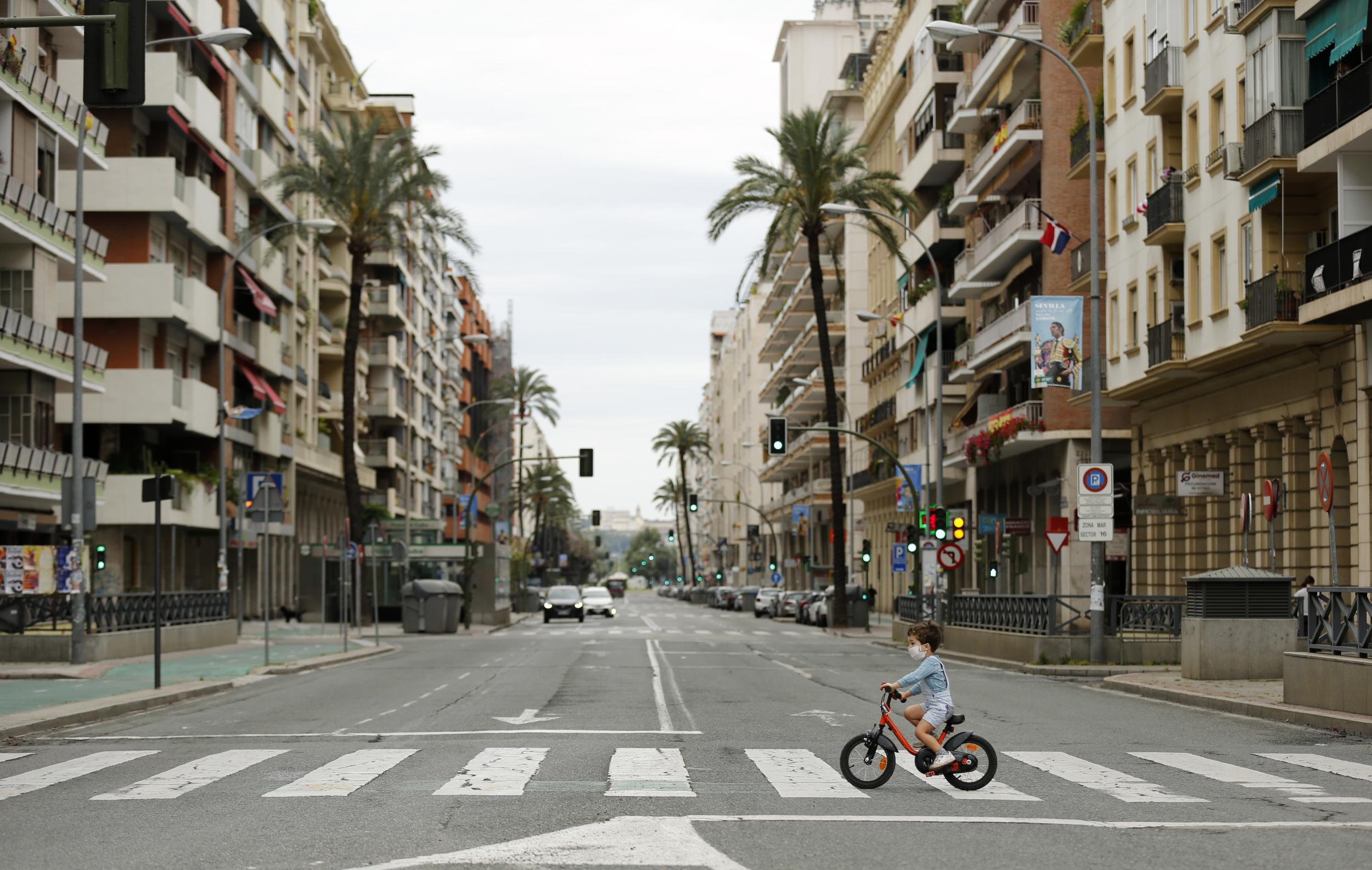Experts worry ‘quarantine fatigue’ is setting in as coronavirus lockdown continues around the world
Experts say because this is first US pandemic in 100 years, they don’t know how long people are willing to tolerate cabin fever for greater good
Your support helps us to tell the story
From reproductive rights to climate change to Big Tech, The Independent is on the ground when the story is developing. Whether it's investigating the financials of Elon Musk's pro-Trump PAC or producing our latest documentary, 'The A Word', which shines a light on the American women fighting for reproductive rights, we know how important it is to parse out the facts from the messaging.
At such a critical moment in US history, we need reporters on the ground. Your donation allows us to keep sending journalists to speak to both sides of the story.
The Independent is trusted by Americans across the entire political spectrum. And unlike many other quality news outlets, we choose not to lock Americans out of our reporting and analysis with paywalls. We believe quality journalism should be available to everyone, paid for by those who can afford it.
Your support makes all the difference.Researchers tracking smartphone data say they recently made a disturbing discovery: for the first time since states began implementing stay-at-home orders in mid-March to limit the spread of the novel coronavirus, Americans are staying home less.
The nationwide shift during the week of 13 April was relatively slight. However, any loss of momentum, particularly when stay-in-place orders remain in effect across most of the country, has some public health experts worried about “quarantine fatigue”. Any increase in travel, they say, is premature when staying home remains the most effective way to limit the spread of the virus until widespread testing and contact tracing become available.
“We saw something we hoped wasn’t happening, but it’s there,” said Lei Zhang, lead researcher and director of the Maryland Transportation Institute at the University of Maryland. “It seems collectively we’re getting a little tired. It looks like people are loosening up on their own to travel more.”
Zhang said he anticipates the number of people staying home will continue to drop as some states begin allowing businesses, beaches and other public facilities to reopen. That process began last week in South Carolina and Georgia.
Public health experts say any data showing widespread public resolve or cooperation beginning to wane is noteworthy. Because this is the first US pandemic in 100 years, they don’t know how long people are willing to tolerate cabin fever for the greater good.
They say they’re not surprised, however, that a slide occurred in a week that saw the first highly publicised challenges to such orders by protesters and President Donald Trump, who tweeted his support to “liberate” states from shutdowns. The White House also released federal guidelines that week for states seeking to reopen their economies. And a growing number of governors, including in Texas, Minnesota and Vermont, set dates for when they planned to gradually lift restrictions.
By 17 April, the researchers found, the share of people presumed to have stayed home — meaning their phones didn’t move at least a mile that day — declined from a national average of 33 per cent to 31 per cent, compared with the previous Friday. That came after six weeks of the staying-home percentage increasing or holding steady.
The number of work trips remained about the same. However, the average number of personal daily trips grew to 2.5 per person, up from 2.4 the previous Friday — a 4 per cent increase. Trips between counties and states also increased.
Because the study’s sample size is so large — more than 100 million cellphones observed monthly — even slight changes are statistically significant, Zhang said.
Dr Wilbur Chen, an associate professor at the University of Maryland School of Medicine, said it’s too soon to know whether the findings reveal a one-week blip or the start of a trend. Chen, a member of Republican governer Larry Hogan’s Covid-19 task force in Maryland, said he’s keeping a close eye on the data, but researchers won’t know for several weeks if more travel led to more coronavirus hospitalisations or deaths — the two most reliable measures of the virus’ spread.

“But it all makes sense,” Chen said. “If people are out and about, there’s more risk of transmission, and when there’s transmission, you have more cases of hospitalisations and deaths.”
George Rutherford, an epidemiology professor at the University of California at San Francisco, said he’s concerned to hear that more people are venturing out while infections remain on the rise in much of the country.
“We’re going to have to do this carefully,” Rutherford said of states beginning to ease restrictions. “Letting people decide for themselves because they’re bored is not a good way to do it. This is not the time to be letting up.”
Experts have theories about why the week of 13 April, the most recent data available, became a tipping point. Many homebound Americans hit the mental milestone of the fifth week, technically entering a second month, with no clear end in sight. Even with the boom in video calls and virtual cocktail hours, they say, feelings of loneliness and isolation continue to mount. Balmy spring temperatures also probably drew people out, particularly in warmer regions where a hot, sticky summer will soon descend.
It’s also no coincidence, they say, that resolve would begin to wane amid the Trump-supported protests, even as most Americans tell pollsters they support stay-at-home requirements.
Lorien Abroms, a public health professor at George Washington University, said it doesn’t help that the public has received “mixed messages”, including Trump’s “tacit support” of the protesters.
“I think the message is getting out that you can give in to your fatigue and say ‘It’s enough’,” Abroms said.
Some people also might have mistakenly believed they could safely start bending the stay-at-home rules, experts say, when some governors began to publicly announce how and when their economies would begin to reopen.
“People can feel it’s coming, so they get more antsy,” said Susan Hassig, an associate professor of epidemiology at Tulane University. “It’s kind of like a kid before Christmas.”
Governors in Georgia, South Carolina and Tennessee announced reopening dates on Monday, after the latest cellphone data was analysed. However, the percentages of people staying home in those states as of 17 April already were among the lowest in the country, between 23 per cent and 26 per cent.
Travis Gayles, the chief health officer in Montgomery County, Maryland, called the potential problem of residents losing patience “an important point that I think every jurisdiction across the country is grappling with in terms of making sure we reinforce our message related to shelter-in-place.”

Gayles said he wasn’t familiar with the data, but questioned whether Montgomery residents might have ventured out more after the county began requiring shoppers to wear face coverings in stores, pharmacies and other retailers.
Even so, Gayles said, “The message is very clear. We’re still encouraging folks to stay home and only come out when they need to,” such as to go to work or the grocery store.
The reversal first became apparent last week, when the Maryland researchers continued to analyse the movements of smartphones via location data from apps. The aggregated and anonymous data, while imperfect, is an easily obtainable and consistent way to measure how much people move about, Zhang said. He said researchers are sharing the mobility data with government officials and epidemiologists modelling the spread of Covid-19.
The nationwide drop in the researchers’ “social distancing index” started on 14 April. That was one day before thousands of protesters in Michigan received national attention for jamming roads around the state capitol, demanding that the restrictions be eased and people be allowed to return to work.
The social distancing index reflects how much people stay home, as well as how much and how far they travel by plane, car, transit, bicycle and on foot, Zhang said. Phones that didn’t make any stops of 10 minutes or more, such as those on people out for a bike ride or walk with the dog, were counted as staying home, Zhang said.
In the Washington region, the District of Columbia and its suburbs all saw an increase in travel and a 1 per cent to 5 per cent drop in people staying home by 17 April. The biggest drop occurred in Arlington County, Virginia, where 50 per cent of residents stayed home, down from 55 per cent the previous Friday. However, Arlington tied with the District for the highest percentage in the region.
In Montgomery County, Maryland, the number of those staying home fell from 45 per cent to 43 per cent, while Prince George’s County fell from 37 per cent to 34 per cent. In Northern Virginia, Fairfax County dropped from 46 per cent to 44 per cent, while Prince William County ended the week with 34 per cent and Loudoun County with 37 per cent.
Of course, the data has its limits. Zhang said researchers are still trying to determine where people are going. If someone takes a round-trip drive to walk alone in the woods, for example, they would be counted as making two trips, even though they weren’t any more likely to spread or catch the virus.
Hassig, of Tulane, said the data is interesting because the United States has such limited experience requiring residents to stay home for lengthy periods. Any quarantines typically are small enough that local health officers can check in daily to monitor people’s symptoms and encourage them to stay isolated. Moreover, she said, most last a maximum 14 to 21 days. “We can usually reduce the likelihood of substantial quarantine fatigue,” Hassig said. “On this massive scale, the support and encouragement can get lost.”
The coronavirus stay-at-home orders are far less restrictive than quarantines, but public health experts say convincing people to stay in will become harder as the weeks pass. The more effectively such orders lower rates of infection, they say, the more some people will incorrectly assume they’re no longer necessary.
Most importantly, experts say, governments wanting to discourage people from venturing out need to better understand why they’re doing so. The response to restlessness, for example, might be to reopen larger parks or close more streets to traffic to allow people to get outdoors at safe distances. If some people are starting to drive for Uber or Lyft because they lost their retail job, the response might be more financial aid. For those feeling cut off, experts say, government messages of sympathy and compassion would help.
“The isolation is real. The loneliness is real,” said Abroms, of GWU. “We need to add that in our messaging. We have to acknowledge that it’s not easy to stay home.”
The Washington Post

Join our commenting forum
Join thought-provoking conversations, follow other Independent readers and see their replies
Comments